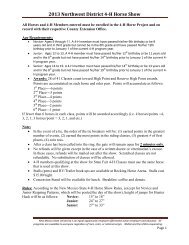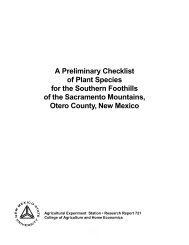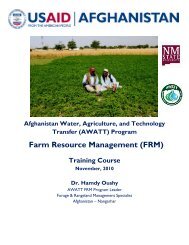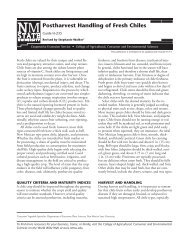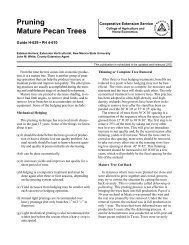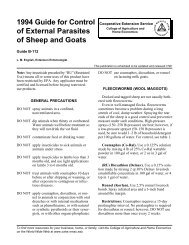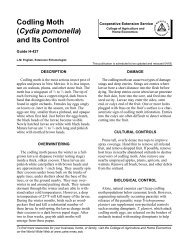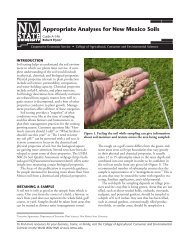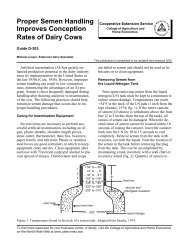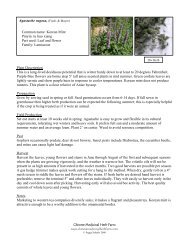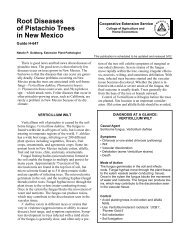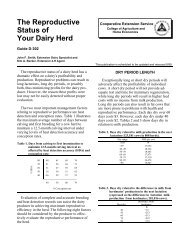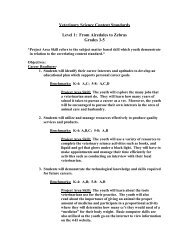Managing Milk Composition: Maximizing Rumen Function - NMSU's ...
Managing Milk Composition: Maximizing Rumen Function - NMSU's ...
Managing Milk Composition: Maximizing Rumen Function - NMSU's ...
You also want an ePaper? Increase the reach of your titles
YUMPU automatically turns print PDFs into web optimized ePapers that Google loves.
<strong>Managing</strong> <strong>Milk</strong><strong>Composition</strong>:<strong>Maximizing</strong> <strong>Rumen</strong> <strong>Function</strong>Cooperative Extension ServiceCollege of Agriculture andHome EconomicsN EW MEXU NICOSTAEI V E R SI T YTGuide D-105Michael L. Looper; 1 Sandra R. Stokes; 2 Dan N. Waldner; 3 and Ellen R. Jordan 2Various feeding management practices impactthe levels of milk fat and protein concentration inraw milk. Feeding strategies that optimize rumenfunction also maximize milk production and milkcomponent percentages and yield. There are severalstrategies that producers can use to enhance rumenfunction and the resulting milk components. Producerswho use records, such as those providedby DHIA (Dairy Herd Improvement Association),can critically evaluate their nutrition and feedingmanagement programs.Feed Intake: Feed provides the nutrients thatare the precursors, either directly or indirectly, ofthe principal milk solids. Thus, an increase in feedintake usually results in the production of a greatervolume of milk. In general, the proportional increasesin fat, protein and lactose yields are approximatelythe same as the proportional increase in milk volume.<strong>Milk</strong> composition changes little.It is critical to maximize feed intake of cattle sothat negative energy balance is minimized duringearly lactation. As cows consume more energy thanthey use, body weight is regained, losses in bodycondition are minimized and cows produce milk ofnormal fat and protein content. Increasing feed intake,and the resulting overall increase in energy, canincrease milk protein content by 0.2 to 0.3 percent.High producing cows should eat 3.5 to 4.0 percentof their body weight daily as dry matter. If a herdis consuming less than this, production of solidscorrectedmilk may be limited. Major factors thatcan affect feed intake include:• Feed bunk management (keep feed bunksclean, not empty)• Feeding frequencyThis publication is scheduled to be updated and reissued 1/06.• Feed sequencing• Ration moisture between 25 and 50 percent(to optimize dry matter intake)• Social interactions and grouping strategy ofthe herd• Abrupt ration changes• Physical facilities• Environmental temperature.Increased feeding frequency of low fiber, highgrain diets increases milk fat levels. The greatestincrease occurs in diets of less than 45 percentforage and when grain is fed separately as in parlorfeeding. When diets are fed as a total mixed ration,feeding frequency becomes less important as longas the feed remains palatable and is fed andmixed a minimum of once a day. During hotweather, more frequent feeding helps keep feedfresh and palatable.Forage to Concentrate Ratio: On a DM (drymatter) basis, the minimum ratio of forage toconcentrate required to maintain normal milk fatpercentage is approximately 40-to-60. This ratioshould serve only as a guide; other dietary factorsinfluence the general effects that a decreased ratiohas upon rumen fermentation. These effects includedecreased rumen pH, increased propionic acidproduction and reduced fiber digestion. Obviously,type and physical form of ingredients that contributeto the forage or concentrate portion of this ratiomust be considered.Grain Feeding: The proper feeding of concentratesinvolves maintaining proper forage-to-concentrateratios and nonfiber carbohydrate levels.Feeding appropriate nonfiber carbohydrate levelscan improve both milk fat and protein levels,1 Extension Dairy Specialist, New Mexico State University; 2 Extension Dairy Specialist, The Texas A&M University System; 3 Extension DairySpecialist, Oklahoma State University.To find more resources for your business, home, or family, visit the College of Agriculture and Home Economicson the World Wide Web at www.cahe.nmsu.edu
while overfeeding leads to milk fat depression ofone unit or more and often increases milk proteinpercent by 0.2 to 0.3 units.Nonfiber carbohydrates include starch, sugarsand pectin. The percentage of nonfiber carbohydrateis calculated as NFC = 100 - (% Protein + %NDF + % Fat + % Ash). Depending on the digestibilityof the neutral detergent fiber (NDF)present, nonfiber carbohydrates should rangefrom 34 to 40 percent of the total ration dry matter.In most instances, a nonfiber carbohydrate levelbetween 36 to 38 percent is considered ideal. Thislevel is typical of diets with less than 60 percentforage. Diets with greater than 60 percent foragemay be deficient in nonfiber carbohydrates.When feeding for component changes, limitthe amount of grain consumed during one feedingto 5 to 7 pounds to avoid rumen acidosis and off-feedproblems that result in reduced fat content ofmilk. Grain feeding guidelines to maximize milkfat and protein production are provided in Table 1.Limit grain consumption to a maximum of 30 to35 pounds per cow daily.Table 1. Grain feeding guidelines.Breed <strong>Milk</strong> Production Grain FeedingGuidelineHolstein andBrown Swiss Less than 40 lbs. 1 lb. per 4 lbs. of milk40 to 70 lbs. 1 lb. per 3 lbs. of milkGreater than 70 lbs. 1 lb. per 2.5 lbs. of milkJersey, Ayrshireand Guernsey Less than 30 lbs. 1 lb. per 3 lbs. of milk30 to 60 lbs. 1 lb. per 2.5 lbs. of milkGreater than 60 lbs. 1 lb. per 2 lbs. of milkAdapted from B. Mahanna. 1995. Hoard’s Dairyman. Vol. 140, No. 15., p. 617.Manure containing large amounts of undigestedcorn or with a pH less than 6.0 can indicate toomuch grain or an imbalance of nonfiber carbohydratesin the diet. Fibrous byproducts such assoybean hulls can replace starchy grain and reducethe severity of milk fat depression in rations highin nonfiber carbohydrate.Grain Processing: The type of grain and processingmethod can have a significant impact onthe site and extent of starch digestion of a particulardiet and resulting milk component composition andyield (Table 2). Generally, ground, rolled, heated,steam flaked or pelletized grain increases starchdigestibilities and propionic acid production inthe rumen. Steam flaked corn or sorghum comparedto steam rolled corn or dry rolled corn or sorghumconsistently improves milk production and milkprotein yield. In six comparisons, steam flakedcorn increased milk protein percentage and yieldand decreased milk fat percentage compared tosteam rolled corn. <strong>Milk</strong> fat yield remained unchangedin these trials. Twenty-four (24) comparisons ofdry rolled and steam flaked sorghum have producedsimilar results. These results are attributed toincreased total tract starch digestibility, increasedrecycling of urea to the intestinal tract and increasedmicrobial protein flow to the small intestine.Table 2. Rate of rumen starch digestion as impacted bygrain type and processing method.RateFastIntermediateSlowGrain Type/Processing MethodDry rolled wheatDry rolled barleyHigh moisture corn (ground)Steam flaked cornHigh moisture corn (whole)Steam flaked sorghumDry rolled cornWhole cornDry rolled sorghumExtensive use of grains, such as wheat, thatconsist of a rapidly fermentable carbohydrate andover-processing of grains can result in severemilk fat depression, off-feed problems and reducedmilk yield. It is important to match carbohydrateand protein sources and to carefullymonitor nonfiber carbohydrate levels in the dietto ensure proper fermentation patterns and tomaximize milk component content and yield.Ration Fiber Levels: The level of fiber feedingand the physical size of fiber particles contributeto the effectiveness of a fiber source for stimulatingrumination (cud chewing), buffer production(salivation) and maintenance of normal milk fatand protein composition. Feeding of finelyground forages inadequately stimulates ruminationand lowers saliva production. This results ina rumen fermentation pattern that produces ahigher proportion of propionic acid and, in turn,reduces milk fat percentage. In most situations,forage comprises no less than 40 to 50 percent ofthe total ration dry matter or should be includedin the diet at no less than 1.40 percent of bodyweight. Cows should receive a minimum of 5pounds of roughage (fiber) that is at least 1.5inches long per day.Guide D-105 • Page 2
Cows require a minimum acid detergent fiber(ADF) level of 19 to 21 percent in the ration drymatter. Maintain total neutral detergent fiber(NDF) intake above 26 percent of the total rationdry matter. Provide 75 percent of the NDF as forage.Below these levels, cows are at an increasedrisk for acidosis, feed intake fluctuations, laminitisand rapid and extensive body condition loss especiallyin early lactation. Suggested guidelines forNDF intakes from forages are presented in Table 3.Table 3. Forage and total neutral detergent fiber(NDF) intake guidelines.Forage NDFTotal NDF Intake(% of Body Weight) (% of Body Weight)0.75 - 0.80 1.30 - 1.400.85 1.10 - 1.200.90 - 1.20 1.10 - 1.20Adapted from Varga et al., 1998. J. Dairy Science 81:3063.Protein Feeding Guidelines: Generally, dietarycrude protein level affects milk yield but not milkprotein percent, unless the diet is deficient incrude protein. Normal changes in dietary proteinranges do not consistently affect milk fat percentage.Theoretically, insufficient amounts of rumen-degradableprotein might result in decreased milkfat percentage if the concentration of ammonia inthe rumen does not support the optimal digestionof fiber and microbial growth.The crude protein requirement for a 1,350-poundcow producing 3.6 percent milk fat ranges from14.0 percent of total dry matter (TDM) for 50pounds of milk to 18.0 percent TDM for 100pounds of milk. Depending on the stage andlevel of production, the recommended level ofundegradable intake protein (UPI) ranges from 32to 38 percent of crude protein. Keep soluble proteinbetween 30 to 32 percent of crude protein, orabout half of the degradable protein intake level.It is essential to meet the cow’s requirementfor both crude protein and rumen undegradableprotein to avoid a negative impact on dry matterintake and fiber digestibility. Studies of dietscontaining no supplemental fat show that each1 percent increase in dietary protein, within therange of 9 to 17 percent, results in a 0.02 percentageunit increase in milk protein. The additionalsynthesis of protein by mammary tissue likely islinked to limiting amino acids. Table 4 summarizesthe various feeding management practices andtheir potential impact on milk fat and proteinconcentration.Table 4. Summary of feeding management practices andtheir potential impact on milk fat and proteinconcentration.Management Factor <strong>Milk</strong> Fat (%) <strong>Milk</strong> Protein (%)Increase feed intake Increase IncreaseIncrease feeding frequency Increase Increase slightlyUnderfeeding energy Decrease DecreaseHigh NFC (>45 %) Decrease IncreaseNormal NFC (34 - 40 %) Increase No changeExcessive fiber Increase slightly DecreaseLow fiber (< 26 % NDF) Decrease IncreaseSmall particle size Decrease IncreaseHigh crude protein No effect Increase if dietis deficientLow crude protein No effect Decrease if dietis deficientUIP (34 - 38 %) No effect Increase if dietis deficientAn increase in feed intake usually results in the production of a greater volume of milk.Guide D-105 • Page 3
New Mexico State University is an equal opportunity/affirmative action employer and educator. NMSU and the U.S. Department ofAgriculture cooperating.February 2001Guide D-105 • Page 4Las Cruces, NM5C



